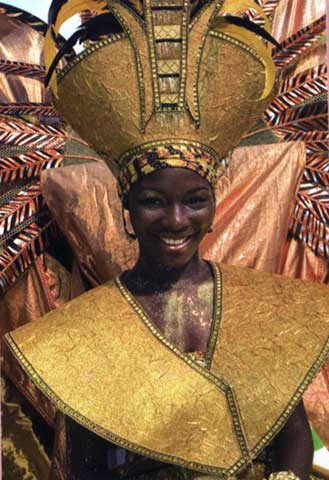THE BUSINESS OF BACCHANAL
By Sharon Williams
St. Lucia changed the date of carnival and made the festival a financial success story.
 Carnival is an annual splash of tradition with dancing in the streets, steel band music and calypso – the music of the islands. It is rooted in slavery and the Catholic religion. Islanders are permitted to release their inhibitions two days before the restrictions of Lent.
Carnival is an annual splash of tradition with dancing in the streets, steel band music and calypso – the music of the islands. It is rooted in slavery and the Catholic religion. Islanders are permitted to release their inhibitions two days before the restrictions of Lent.
In St. Lucia, one of the main problems with the conventional date of carnival coming at the beginning of the year was its proximity to Christmas festivities, a season when locals fix their homes and redecorate. They slaughter and cook all kinds of livestock and do a lot of drinking and partying. People needed more time to recover financially before they started about the business of carnival.
“One year, I remember carnival was on February 7th and with the four days of Assou Square, our national New Years’ festivities, people had less than a month to prepare for carnival,” explained Teddy Francis Executive Director of the Cultural Development Foundation (CDF), the organizing body of the annual carnival.
St. Lucian carnival planners made a controversial decision, amidst much criticism from the Catholic Church, to change the date of the event. The goal was also to allow more people to come to St. Lucia to partake in the bacchanalia and boost the island’s tourism arrivals.
In 1999, after long drawn-out arguments for and against, the government changed the date from the pre-Lenten season to the summer month of July.
The move was embraced by band leaders, costume-designers and builders, but provided fodder for the calypsonians. That year one of them sang: “they move carnival from lent to hurricane” hinting that the event was now squarely placed during the annual hurricane season, a factor that has hampered festivities a few times.
On the positive side, the new date allowed for growth in the island’s tourism industry. A 14.4% increase in visitor arrivals was recorded for that period with 2,360 visitors coming to St. Lucia for carnival.
Interest from other Caribbean islands grew and arrivals from the French Caribbean islands of Guadeloupe and Martinique increased significantly. In 2005 alone, 1,500 Martiniquans flocked to St. Lucia for carnival.
Following the 2006 carnival, the Cultural Development Foundation expressed satisfaction with the growing Martiniquan market. “We had seven costumed bands participating which is quite something.” Francis said.
St. Lucia appeals to the French islanders who enjoy coming here to party.
“While Trinidad may have the best carnival in the region, the date clashes with that in Martinique. We also understand that Martiniquans find Trinidad carnival too big, too impersonal. St. Lucia is intimate and warmer, a nice holiday and infinitely more affordable. There are also historical links between St. Lucia and Martinique,” said Francis.
The new carnival date also allows students returning home for the summer holidays to have a major activity to look forward to.
The Cultural Development Foundation confirms a 33% increase in the number of 17 – 21 year olds taking part in carnival in the last four years.
“The numbers began swelling and band leaders now have to cater to the needs of young revelers. In addition to the university students returning home, schools are closed during carnival and secondary students also want to join in the fun,” added Francis.
As a result of the emerging youth market, three new bands have been created: “XS Energy” which also caters to the 30-somethings; “Just 4 Fun”; and the more recent carnival venture “Red International” with its spectacular headpieces. The band also specializes in two-piece bathing suits lavishly decorated with beads and feathers that reveal as much bare skin as possible – a popular concept among young revelers.
Such skimpiness is a cause for concern among die-hard carnival artisans who believe that the artistry and originality of the festival are being compromised in the rush to please the younger market. Some feel that carnival has degenerated into a parade of naked bodies clad in beaded bathing suits, the only distinctive factors being the colours.
A few costume designers are making an effort to reverse the trend. Bands such as Mas Action multi-winner of the much coveted Band of the Year title and Rituals cater to a more mature reveler.
Veteran carnival designer, Adrian Augier of Rituals, has added the tag line: “Mas with Meaning” to his band ensuring that his portrayals are theatrical productions, taken to the road.
“When spectators have had their fill of gyrating, naked bodies, along comes Rituals, telling a story and stimulating the audience,” Augier explained.
One unique event that has emerged from the change of date is the Caribbean Soca Monarch competition now into its sixth year and the only one of its kind in the region.
Islands across the Caribbean send contenders to compete for the prestigious crown. In 2006, the event recorded a whopping 10,000-member audience, a record-breaking statistic.
“The appeal lies in the jumpiness of soca music,” one organizer admitted, “and we intend to develop this competition to attract even more visitors from neighbouring islands.”
While carnival organizers look for ways to make St. Lucia’s carnival bigger and better, we invite you to try our carnival in July.

